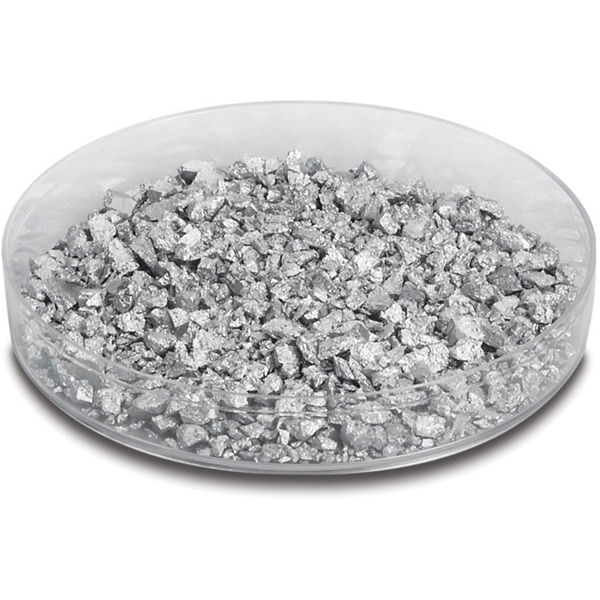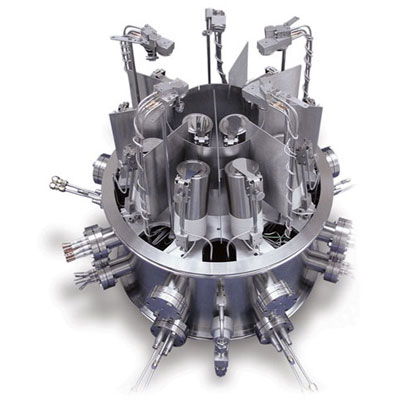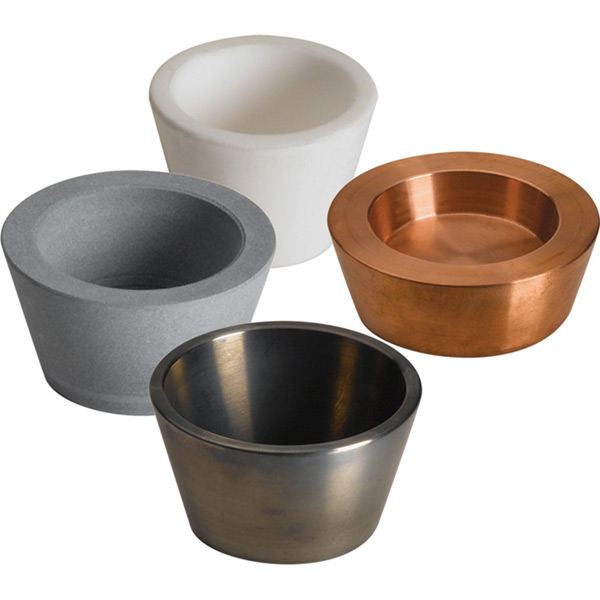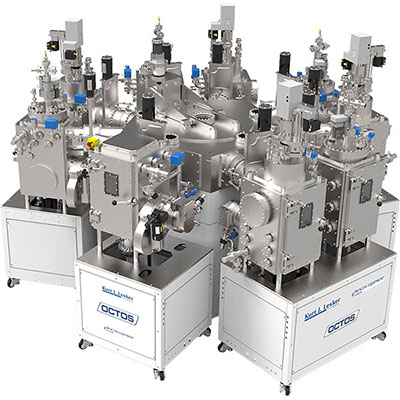Chromium (Cr) Pieces Overview
We sell these pellets and pieces by unit weight for evaporation use in deposition processes. These approximate materials prices are published to provide budgetary guidelines. Actual prices can vary and may be higher or lower, as determined by availability and market fluctuations. To speak to someone directly about current pricing, please click here .
Chromium (Cr) General Information
Chromium is one of the most popular metals in the world. Chromium is a silvery, lustrous, hard, and brittle metal known for its high mirror polish and corrosion resistance. It has a melting point of 1,857°C, a density of 7.2 g/cc, and a vapor pressure of 10-4 Torr at 1,157°C. Its name comes from the Greek word "chroma", which means color, due to its very colorful compounds. It is widely used in the automobile industry to form a shiny coating found on wheels and bumpers. Chromium is used in many vacuum applications such as automotive glass coatings, photovoltaic cell fabrication, battery fabrication, and decorative and corrosion resistant coatings.
Chromium (Cr) Specifications
| Material Type | Chromium |
| Symbol | Cr |
| Atomic Weight | 51.9961 |
| Atomic Number | 24 |
| Color/Appearance | Silvery, Metallic |
| Thermal Conductivity | 94 W/m.K |
| Melting Point (°C) | 1,857 |
| Coefficient of Thermal Expansion | 4.9 x 10-6/K |
| Theoretical Density (g/cc) | 7.2 |
| Z Ratio | 0.305 |
| E-Beam | Good |
| Thermal Evaporation Techniques |
Boat: Cr Plated W Rods Coil: W Basket: W Crucible: VitC |
| E-Beam Crucible Liner Material | FABMATE®, Graphite, Tungsten |
| Temp. (°C) for Given Vap. Press. (Torr) |
10-8: 837 10-6: 977 10-4: 1,157 |
| Comments | Films very adherent. High rates possible. |
| Suggested QCM Crystal | Alloy Crystal: 750-1002-G10**** |
**** Suggestion based on previous experience but could vary by process. Contact local KJLC Sales Manager for further information
Empirical Determination of Z-Factor
Unfortunately, Z Factor and Shear Modulus are not readily available for many materials. In this case, the Z-Factor can also be determined empirically using the following method:
- Deposit material until Crystal Life is near 50%, or near the end of life, whichever is sooner.
- Place a new substrate adjacent to the used quartz sensor.
- Set QCM Density to the calibrated value; Tooling to 100%
- Zero thickness
- Deposit approximately 1000 to 5000 A of material on the substrate.
- Use a profilometer or interferometer to measure the actual substrate film thickness.
- Adjust the Z Factor of the instrument until the correct thickness reading is shown.
Another alternative is to change crystals frequently and ignore the error. The graph below shows the % Error in Rate/Thickness from using the wrong Z Factor. For a crystal with 90% life, the error is negligible for even large errors in the programmed versus actual Z Factor.

Thermal Evaporation of Chromium (Cr)
Chromium can be problematic to thermally evaporate because it will sublime under high temperatures. In order to perform thermal evaporation, a material's temperature must be raised to the point where its equilibrium vapor pressure is 1E-2 Torr. This provides for good deposition rates in systems with "normal" source-to-substrate geometries. According to chromium's vapor pressure curve, the necessary temperature for this to occur is 1,400°C.
Chromium (Cr) Vapor Pressure Chart
Since its melting point is higher (1,857°C), it will sublime from a solid phase. This presents two possible issues. One, heating anything to 1,400°C might generate an unacceptably high thermal load in the chamber. Two, the heat transfer mechanism of solid chromium pieces is almost entirely by thermal radiation which means the heater must be much higher than 1,400°C.
There are two main recommendations for thermally evaporating chromium. The first option is to use chrome plated tungsten rods. These electroplated rods are ideal for depositing very thin adhesion layers. Because the chromium is plated directly on the tungsten rod, heat transfer is by conduction. Sublimation occurs easily and quickly, compared with evaporating from a boat, and affords a potentially much lower thermal load on the chamber. The main disadvantages of these rods are the limited amount of chromium available from each rod and the fact that they are one-time use sources.
The second option is to evaporate the material from a refractory boat. We have reported success in the past using a thin width, thick gauge, high current tungsten boat such as our EVS20A015W. Using this boat, we sublimated chromium pieces with a standard 3.3V 375A KJLC® power supply. There is no interaction between the sublimating chromium and the tungsten boat. The rates are fairly easy to control at 1-5 Angstroms/sec. It is important to note that while the power supply is capable of 1,200W, a lower power was used during sublimation.
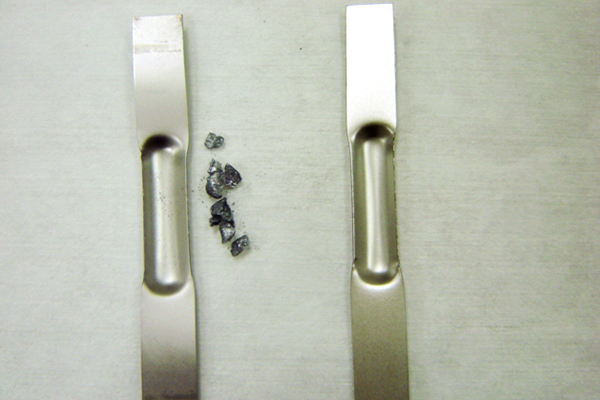
EVS20A015W boat after Cr evaporation run (on left)
Picture of boat used to evaporate Cr pieces(left) taken next to a new boat(right). The Cr pieces are shown outside of the boat. These were left after depositing a 2000Å thick Cr film.
E-beam Evaporation of Chromium (Cr)
Chromium can be e-beam evaporated from a FABMATE®, graphite, or tungsten crucible liner. A key process note is to consider the fill volume of the crucible liner. We find that the melt level of a material in the crucible directly affects the success of the crucible liner. Overfilling the crucible will cause the material to spill over and create an electrical short between the liner and the hearth. The outcome is cracking in the crucible liner. This is the most common cause of crucible liner failure. Placing too little material in the liner or evaporating too much material before refilling can be detrimental to the process as well. When the melt level is below 30%, the e-beam is likely to strike the bottom or walls of the crucible which immediately results in breakage. Our recommendation is to fill the crucible between 2/3 and 3/4 full to prevent these difficulties.
Crucible liners should be stored in a cool, dry place and always handled with gloves or forceps.
Chromium can also be run directly from the copper hearth of the e-gun. Because of this, some customers prefer to use a pre-machined slug (or starter source) that is directly placed in the hearth pocket. The two main benefits of using a starter source are ease of use and handling as well as superior packing density. Because not using a crucible liner is not always an option, especially in shared systems, some customers will use a copper crucible liner and place the starter source in the copper crucible liner instead of placing directly in the hearth.
KJLC® can produce these starter sources. Contact us by clicking here with your e-gun manufacturer, pocket size, and number of pockets in order for us to produce a quote.
See highlighted results that match your result in the table below.
Ordering Table
| More Info | Material | Description | Size | Quantity | Purity | Part Number | Price | In Stock | Add To Cart |
|---|---|---|---|---|---|---|---|---|---|
| More Info | Material | Description | Size | Quantity | Purity | Part Number | Price | In Stock | Add To Cart |
| Chromium |
CHROMIUM PIECES, |
0.8mm - 6mm Pieces | 1 lb. | 99.95% | EVMCR35 | $178.00 |
|
||
| Chromium |
CHROMIUM PIECES, |
0.8mm - 6mm Pieces | 25 g | 99.95% | EVMCR35A | $40.00 |
|
||
| Chromium |
CHROMIUM PIECES, |
0.8mm - 6mm Pieces | 50 g | 99.95% | EVMCR35B | $39.00 |
|
||
| Chromium |
CHROMIUM PIECES, |
0.8mm - 6mm Pieces | 100 g | 99.95% | EVMCR35D | $49.00 |
|
||
| Chromium |
CHROMIUM PIECES, |
0.8mm - 6mm Pieces | 250 g | 99.95% | EVMCR35J | $95.00 |
|
||
| Chromium |
CHROMIUM PIECES, |
0.8mm - 6mm Pieces | 1 kg | 99.95% | EVMCR35KG | $288.00 |
|
||
| Chromium |
CHROMIUM PIECES, |
0.8mm - 6mm Pieces | 500 g | 99.95% | EVMCR35T | P.O.R. |
|




